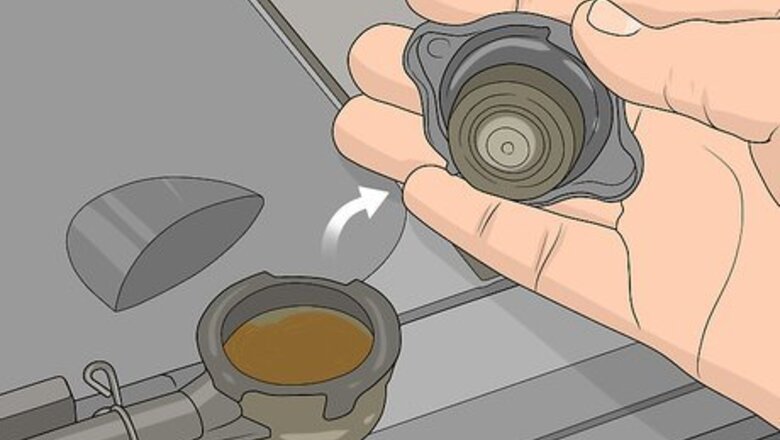
views
Observing the Coolant Flow
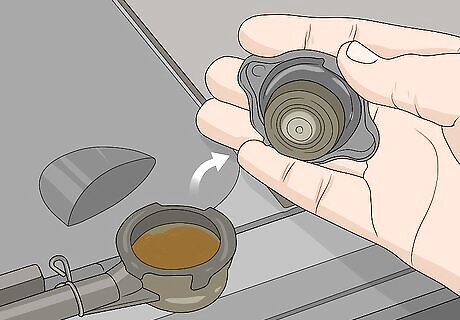
Take the cap off of your radiator. Open the hood of your vehicle and prop it up so it doesn’t fall back down during your test. Locate the radiator, which looks like a narrow silver or black box, and is at the front of your vehicle directly behind the grill. Look for the circular metal cap on the left or right side of the radiator and turn it counterclockwise to loosen it. If you’ve driven recently, wait until the engine cools completely before starting. Otherwise, the test may be inaccurate. Don’t open the radiator cap immediately after running your vehicle since it could be extremely hot and cause burns.
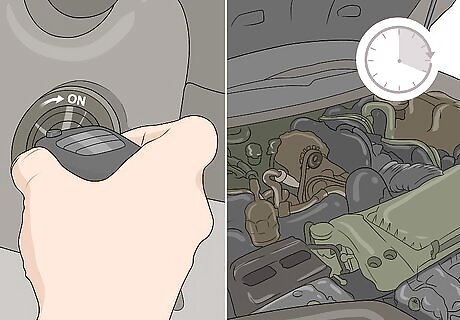
Start your engine and let it idle for 10-20 minutes. Leave your vehicle in park and turn it on so the engine starts. From a cold start, your vehicle’s thermostat will stay closed and you won’t notice any coolant flowing into your radiator. Leave the vehicle running for about 10-20 minutes so it can reach its optimal running temperature. If you notice coolant flowing into the radiator right when you start your vehicle, then the thermostat is stuck in the open position. Don’t run your vehicle in an enclosed space since it will create harmful fumes.
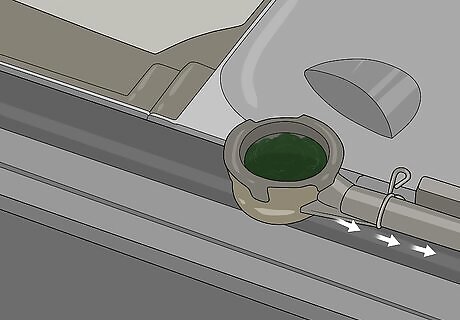
Look into your radiator to check if coolant is flowing through it. After 10-20 minutes pass, keep your head at least 1–2 feet (30–61 cm) away and look down into the radiator where you removed the cap to check on the coolant. As the engine heats up, the thermostat should open up and allow the coolant to flow from the radiator to the engine. If you see the coolant flowing through the radiator, then the thermostat opened and is working properly. If not, then it is most likely stuck closed. If you can’t tell if the coolant in the radiator is flowing, shine a flashlight inside so you can see it better.
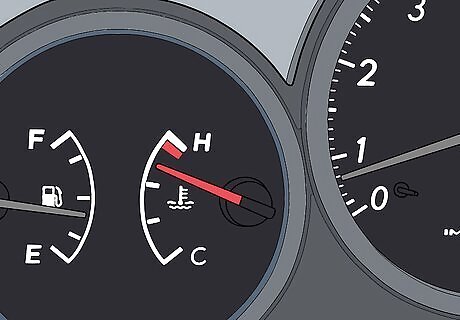
Check if the engine temperature gauge enters the red danger zone. While your vehicle is still running, check the engine temperature gauge on your dashboard to see if it’s rising. If the engine temperature is in the red section of the gauge and the coolant doesn’t flow into the radiator, then the thermostat may be the cause of your problem. The temperature that your engine overheats will vary depending on the make and model of your vehicle, though most engines overheat above 220 °F (104 °C).Tip: If your engine overheats but the coolant still flows through your radiator, then your vehicle may be overheating for a different reason, such as a faulty water pump or a leaking cooling system.
Measuring the Engine and Hose Temperatures

Start your vehicle to let the engine idle. Move your vehicle outside so exhaust fumes can escape. Put your vehicle in park or activate the parking brake before turning on the engine. Let the engine run throughout the entire test so it can heat up the coolant inside. If you’re worried about your vehicle possibly moving, put blocks in front of each tire to keep it in place.
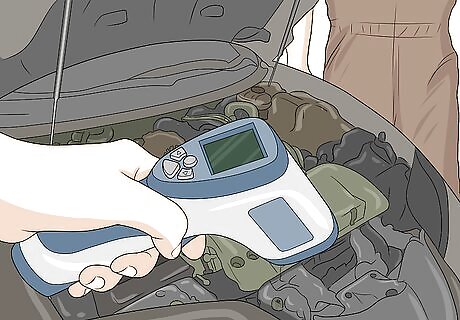
Check the temperature of the engine with an infrared thermometer. Take an initial temperature reading as soon as you start your vehicle. Locate the thick black hose that runs from the side of the radiator to the top or side of the main engine block. Point the infrared thermometer where the hose connects to the engine and pull the trigger to measure the temperature. Wait until the number on the thermometer settles before writing the temperature down. You can buy an infrared thermometer from your local hardware store or online.Variation: If you don’t have an infrared thermometer, you can also lightly touch the area by hand to test how hot it feels, but it won’t be as accurate. Don’t hold your fingers on the engine too long or else you could burn yourself.

Take the temperature of the upper radiator hose. Point the thermometer at the black radiator hose connected to the engine so it’s about 3–4 inches (7.6–10.2 cm) away from where you recorded the first measurement. Pull the trigger on the thermometer to take the temperature of the hose. Write down the measurement you found so you don’t forget it later on. The temperature for the radiator hose should be lower than the temperature of the engine. If they are the same, then the thermostat is stuck in the open position. Take the temperature of the lower radiator hose as well. If there's an imbalance between them, it's probably a sign that your car's thermostat is closed.
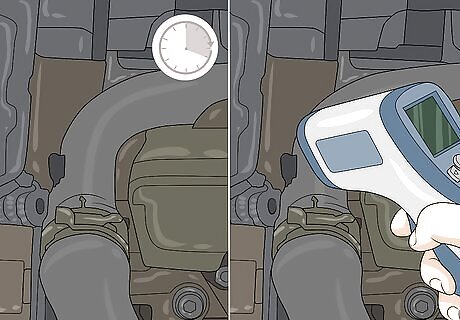
Measure the temperatures again after 10-15 minutes. Let your engine continue running for at least 10-15 minutes so the engine can heat up to its optimal running temperature. Record your measurements from the same places you took them earlier and write down the results so you can compare them. Watch the engine temperature gauge on your vehicle’s dashboard to see if it enters the red danger zone, which means the engine is too hot and could overheat. If you notice your vehicle overheating, turn off the engine right away to avoid causing further damage.
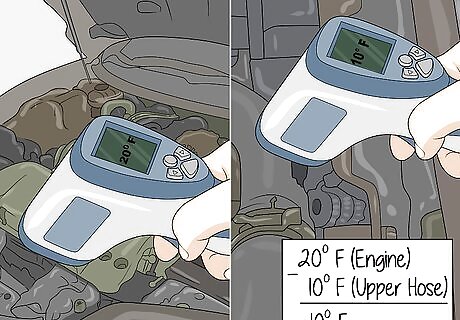
Check if the measurements are within 10° F (18° C) of each other. Look at the temperature of the engine and the upper hose after your vehicle has run for 10-15 minutes. If the temperatures are within 10° Fahrenheit (18° Celsius) of one another, then the thermostat is working properly. However, if the hose is still substantially cooler than the engine, then there isn’t any coolant running through it and the thermostat stayed closed. If the hose is the same temperature as the engine but it’s still overheating, then there may be another problem with your vehicle instead of the thermostat.
Testing the Thermostat in Hot Water
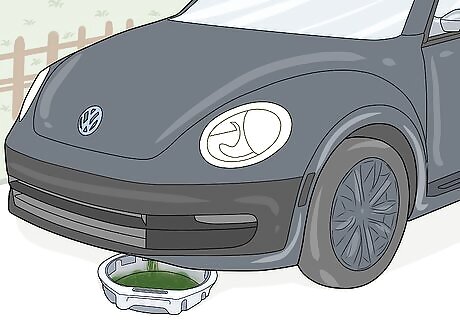
Drain the coolant from the radiator. Crawl underneath the front of your vehicle so you’re below the radiator. Look for the drain plug (the white or black plastic wingnut) near the bottom corner or side of the radiator tank. Place a bucket underneath the drain plug so the coolant doesn’t spill when you drain the radiator. Unscrew the drain plug and let the coolant flow into the bucket until your radiator is empty. Screw the drain plug back onto the tank when you’re finished. Vehicle coolant can be toxic, so keep it away from children or pets. Don’t drain the coolant unless your vehicle and engine are completely cool or else it could be extremely hot and cause burns. If your radiator doesn’t have a drain plug, use a screwdriver to loosen the clamp around the lower radiator hose before pulling it out of place. Then, drain the coolant from the lower hose into the bucket.
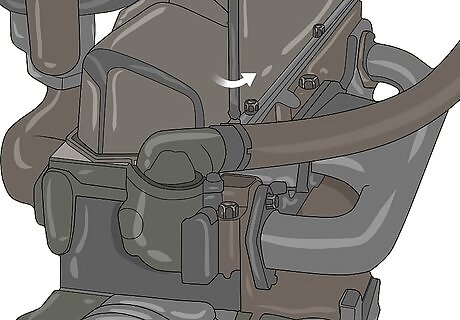
Disconnect the upper radiator hose from the engine. The thick black hose runs from the side of your radiator and attaches to the top or side of your engine block with a tube clamp. Use a screwdriver to loosen the nut on the tube clamp and then pull the hose off of the engine. Set the end of the hose aside for now so you can access the thermostat housing on your engine. Place a shop cloth or rag in the end of the hose to prevent dirt or debris from getting inside it.
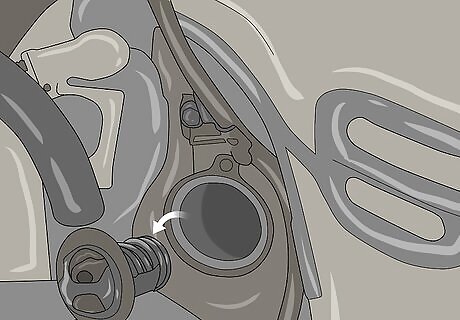
Remove the thermostat after disconnecting the thermostat housing from the engine. The thermostat housing is the blocky metal piece connected to your engine block that the hose was attached to. Use a socket wrench to loosen the bolts holding the housing in place, and set them aside so you don’t lose them. Pull the housing off of the engine to expose the thermostat, which looks like a small metal cylinder with a spring and 2 metal rings around it. Grab the end of the thermostat and pull it out. If it’s difficult to grab the thermostat by hand, use a pair of needle-nose pliers or a screwdriver to pry it out. The bolts for your thermostat housing may be different lengths. Make note of where each bolt went inside the housing so you can reattach it correctly later. Diagnose overheating issues. "My car kept overheating all of a sudden, so I came here to figure out why. Following the tips to check if the coolant was flowing through the radiator, I realized the thermostat must be stuck shut. Now I know what's wrong, thanks to the easy troubleshooting advice—no need to go to the mechanic and pay a bunch of money." - Kee S. Save cash doing your own repairs. "I noticed coolant spilling from the reservoir in my car, which seemed like a clue the thermostat was bad. The step-by-step instructions here gave me the confidence to replace it myself. The pictures made everything really clear. Fixing it on my own this way saved me a ton of money on repairs." - Stanley L. Make car repairs easy to tackle. "I like how this article explains thermostat issues in a way anyone can understand. Testing the old part in hot water before installing the new one let me confirm the problem with my own eyes. Now, thanks to these tips, my aging car's cooling system is working properly again." - Donald M. Quickly identify what's causing overheating. "My old car started overheating all of a sudden, and I wasn't sure why. Going through the logical troubleshooting guide, I checked the coolant flow and realized the thermostat must be stuck. Replacing it on my own got my engine running right again. Now, I can solve overheating problems quickly using the great advice here." - Fiona B. Have a story our readers should hear? Share it with 1 billion+ annual wikiHow users. Tell us your story here.
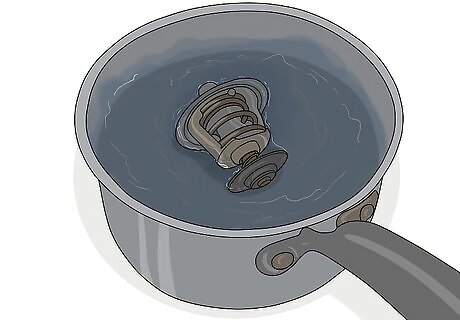
Submerge the thermostat in a pot of water so it doesn’t touch the bottom. Use a pot that’s deep enough to completely submerge the thermostat in water. Fill the pot with water from your faucet and set it on a stove. Hold the top of the thermostat with a pair of tongs so it’s underwater. Don’t let the thermostat rest on the bottom of the pot since it could affect the temperature on the reading. You can also hang the thermostat on the side of the pot with a piece of string or metal clip.

Heat the water until it reaches about 195–220 °F (91–104 °C). Turn your stove onto high heat and place a thermometer in the pot of water so you can record the temperature. Continue heating the water until it reaches 195–220 °F (91–104 °C), which is the temperature engines operate the best. Turn off the heat once your thermometer reads within the range.Tip: Look on the thermostat to see if it has an operating temperature listed. If it does, the thermostat should open once it reaches that temperature.

Take the thermostat out of the pot to see if it’s opened. Pull the thermostat out of the water with your tongs and set it on paper towels to dry it off. As the thermostat heats up, the spring should compress and the center ring will separate from the outer ring to make a gap in the middle. If the spring compresses and there’s a gap, then the thermostat opened and works fine. If the thermostat doesn’t have a gap between the circular metal pieces, then it’s stuck closed and should be replaced. You can get replacement thermostats from an auto supply store or online. Make sure the thermostat matches the model vehicle you have.


















Comments
0 comment